Get Popping!
Students discover how popcorn is grown and explore the phenomenon of how popcorn pops.
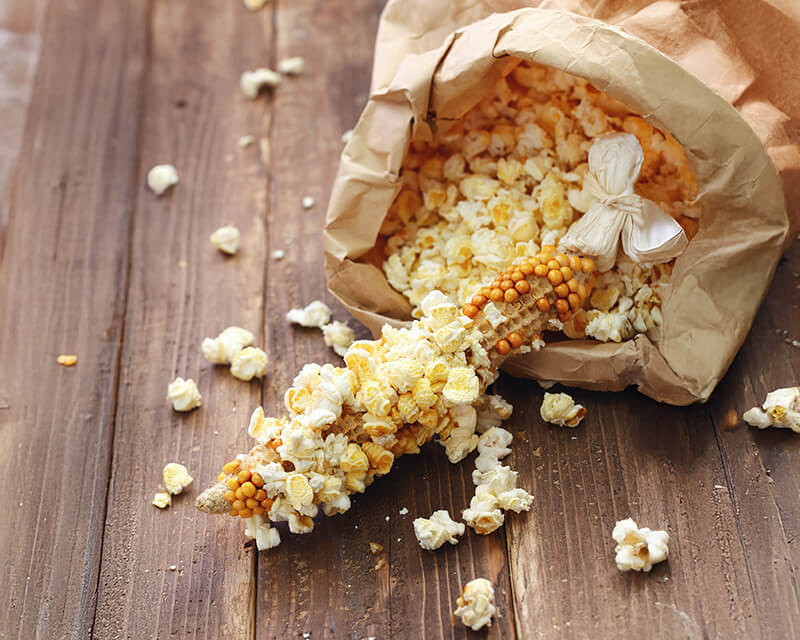
Background
Lesson Activities
Recommended Companion Resources
Credits
Author
Lynn Wallin | National Center for Agricultural Literacy (NCAL)
Acknowledgements
- Storyline graphic from seedstorylines.org.
- Phenomenon chart adapted from work by Susan German.
German, S. (2017, December). Creating conceptual storylines. Science Scope, 41(4), 26-28.
German, S. (2018, January). The steps of a conceptual storyline. Science Scope, 41(5), 32-34. - Activity 3 was created for Utah Agriculture in the Classroom by Lyndi Perry.
Sources
- http://www.popcorn.org/Facts-Fun/Corny-Facts
- https://specialcollections.nal.usda.gov/popcorn-exhibit#pop
- http://www.popcorn.org/Facts-Fun/History-of-Popcorn/Recent-Popcorn-History
Standards
Texas Content Area Standards
-
ELA: 4.110.6.b.1
Developing and sustaining foundational language skills: listening, speaking, discussion, and thinking- oral language. The students develops oral language through listening, speaking, and discussion.
- ELA: 4.1.C: The student is expected to express an opinion supported by accurate information, employing eye contact, speaking rate, volume, enunciation and the conventions of language to communicate ideas effectively.
- ELA: 4.1.D: The student is expected to work collaboratively with other to develop a plan of shared responsibilities.
-
ELA: 5.110.7.b.1
Developing and sustaining foundational language skills: listening, speaking, discussion, and thinking- oral language. The students develops oral language through listening, speaking, and discussion.
- ELA: 5.1.D: The student is expected to work collaboratively with others to develop a plan of shared responsibilities.
-
Social Studies: 3.113.14.c.4
Geography. The student understands the concepts of location, distance, and direction on maps and globes. The student is expected to:
- Social Studies: 3.113.14.c.14.D: interpret and create visuals, including graphs, charts, tables, timelines, illustrations, and maps
-
Science: 3.112.14.b.1
Scientific investigation and reasoning. The student conducts classroom and outdoor investigations following home and school safety procedures and environmentally appropriate practices.
- Science: 3.112.14.b.1.A: The student is expected to demonstrate safe practices as described in Texas Education Agency- approved safety standards during classroom and outdoor investigations using safety equipment as appropriate, including safety goggles or chemical splash goggles, as appropriate, and gloves.
-
Science: 3.112.14.b.2
Scientific investigation and reasoning. The student uses scientific practices during laboratory and outdoor investigations.
- Science: 3.112.14.b.2.A: The student is expected to plan and implement descriptive investigations, including asking and answering questions, making inferences, and selecting and using equipment or technology needed, to solve a specific problem in the natural world.
-
Science: 3.112.14.b.4
Scientific investigation and reasoning. The student knows how to use a variety of tools and methods to conduct science inquiry.
- Science: 3.112.14.b.4.A: The student is expected to collect, record, and analyze information using tools, including cameras, computers, hand lenses, metric rulers, Celsius thermometers, wind vanes, rain gauges, pan balances, graduated cylinders, beakers, spring scales, hot plates, meters sticks, magnets, collecting nets, notebooks, and Sun, Earth, and Moon system modes; timing devices; and materials to support observation of habitats of organisms such as terrariums and aquariums.
-
Science: 3.112.14.b.5
Matter and energy. The student knows that matter has measurable physical properties and those properties determine how matter is classifies, changed, and used.
- Science: 3.112.14.b.5.C: The student is expected to predict, observe, and record changes in the state of matter caused by heating or cooling such as ice becoming liquid water, condensation forming on the outside of a glass of ice water, or liquid water being heated to the point of becoming water vapor.
-
Science: 4.112.15.b.1
Scientific investigation and reasoning. The student conducts classroom and outdoor investigations following home and school safety procedures and environmentally appropriate practices.
- Science: 4.1.A: The student is expected to demonstrate safe practices as described in Texas Education Agency- approved safety standards during classroom and outdoor investigations using safety equipment, including safety goggles or chemical splash goggles, as appropriate, and gloves, as appropriate.
-
Science: 4.112.15.b.2
Scientific investigation and reasoning. The student uses scientific practices during laboratory and outdoor investigations.
- Science: 4.2.A: The student is expected to plan and implement descriptive investigations, including asking well defined questions, making inferences, and selecting and using appropriate equipment or technology to answer his/her questions.
-
Science: 4.112.15.b.4
Scientific investigation and reasoning. The student knows how to use a variety of tools and methods to conduct science inquiry.
- Science: 4.4.A: The student is expected to collect, record, and analyze information using tools, including cameras, computers, hand lenses, metric rulers, Celsius thermometers, wind vanes, rain gauges, pan balances, graduated cylinders, beakers, spring scales, hot plates, meters sticks, magnets, collecting nets, notebooks, and Sun, Earth, and Moon system modes; timing devices; and materials to support observation of habitats of organisms such as terrariums and aquariums.
-
Science: 5.112.16.b.1
Scientific investigation and reasoning. The student conducts classroom and outdoor investigations following home and school safety procedures and environmentally appropriate practices.
- Science: 5.1.A: The student is expected to demonstrate safe practices as described in Texas Education Agency- approved safety standards during classroom and outdoor investigations using safety equipment, including safety goggles or chemical splash goggles, as appropriate, and gloves, as appropriate.
-
Science: 5.112.16.b.2
Scientific investigation and reasoning. The student uses scientific practices during laboratory and outdoor investigations.
- Science: 5.2.A: The student is expected to describe, plan, and implement simple experimental investigations testing one variable.
-
Science: 5.112.16.b.4
Scientific investigation and reasoning. The student knows how to use a variety of tools and methods to conduct science inquiry.
- Science: 5.4.A: The student is expected to collect, record, and analyze information using tools, including cameras, computers, hand lenses, metric rulers, Celsius thermometers, wind vanes, rain gauges, pan balances, graduated cylinders, beakers, spring scales, hot plates, meters sticks, magnets, collecting nets, notebooks, and Sun, Earth, and Moon system modes; timing devices; and materials to support observation of habitats of organisms such as terrariums and aquariums.
-
Science: 5.112.16.b.5
Matter and energy. The student knows that matter has measurable physical properties and those properties determine how matter is classifies, changed, and used.
- Science: 5.5.A: The student is expected to classify matter based on measurable, testable, and observable physical properties, including mass, magnetism, physical state (solid, liquid, and gas), relative density (sinking and floating using water as a reference point), solubility in water, and the ability to conduct or insulate thermal energy or electric energy.
-
Social Studies: 4.113.15.c.19
Social studies skills. The student applies critical-thinking skills to organize and use information acquired from a variety of valid sources, including technology. The student is expected to:
- Social Studies: 4.113.15.c.19.D: organize and interpret information in outlines, reports, databases, and visuals, including graphs, charts, timelines, and maps
-
Social Studies: 5.113.16.c.23
Social studies skills. The student applies critical-thinking skills to organize and use information acquired from a variety of valid sources, including technology. The student is expected to:
- Social Studies: 5.113.16.c.23.D: organize and interpret information in outlines, reports, databases, and visuals, including graphs, charts, timelines, and maps
-
Science: 3.112.5.b.1
Scientific and engineering practices. The student asks questions, identifies problems, and plans and safely conducts classroom, laboratory, and field investigations to answer questions, explain phenomena, or design solutions using appropriate tools and models. The student is expected to:
- Science: 3.112.5.b.1.B: use scientific practices to plan and conduct descriptive investigations and use engineering practices to design solutions to problems
- Science: 3.112.5.b.1.C: demonstrate safe practices and the use of safety equipment during classroom and field investigations as outlined in Texas Education Agency-approved safety standards
- Science: 3.112.5.b.1.D: use tools, including hand lenses; metric rulers; Celsius thermometers; wind vanes; rain gauges; graduated cylinders; beakers; digital scales; hot plates; meter sticks; magnets; notebooks; Sun, Earth, Moon system models; timing devices; materials to support observation of habitats of organisms such as terrariums, aquariums, and collecting nets; and materials to support digital data collection such as computers, tablets, and cameras, to observe, measure, test, and analyze information
-
Science: 3.112.5.b.6
Matter and energy. The student knows that matter has measurable physical properties that determine how matter is identified, classified, changed, and used. The student is expected to:
- Science: 3.112.5.b.6.C: predict, observe, and record changes in the state of matter caused by heating or cooling in a variety of substances such as ice becoming liquid water, condensation forming on the outside of a glass, or liquid water being heated to the point of becoming water vapor (gas)
-
Science: 4.112.6.b.1
Scientific and engineering practices. The student asks questions, identifies problems, and plans and safely conducts classroom, laboratory, and field investigations to answer questions, explain phenomena, or design solutions using appropriate tools and models. The student is expected to:
- Science: 4.112.6.b.1.B: use scientific practices to plan and conduct descriptive investigations and use engineering practices to design solutions to problems
- Science: 4.112.6.b.1.D: use tools, including hand lenses; metric rulers; Celsius thermometers; calculators; laser pointers; mirrors; digital scales; balances; graduated cylinders; beakers; hot plates; meter sticks; magnets; notebooks; timing devices; sieves; materials for building circuits; materials to support observation of habitats of organisms such as terrariums, aquariums, and collecting nets; and materials to support digital data collection such as computers, tablets, and cameras, to observe, measure, test, and analyze information
- Science: 4.112.6.b.1C: demonstrate safe practices and the use of safety equipment during classroom and field investigations as outlined in Texas Education Agency-approved safety standards
-
Science: 5.112.7.b.1
Scientific and engineering practices. The student asks questions, identifies problems, and plans and safely conducts classroom, laboratory, and field investigations to answer questions, explain phenomena, or design solutions using appropriate tools and models. The student is expected to:
- Science: 5.112.7.b.1.B: use scientific practices to plan and conduct descriptive investigations and use engineering practices to design solutions to problems
- Science: 5.112.7.b.1.C: demonstrate safe practices and the use of safety equipment during classroom and field investigations as outlined in Texas Education Agency-approved safety standards
- Science: 5.112.7.b.1.D: use tools, including calculators, microscopes, hand lenses, metric rulers, Celsius thermometers, prisms, concave and convex lenses, laser pointers, mirrors, digital scales, balances, spring scales, graduated cylinders, beakers, hot plates, meter sticks, magnets, collecting nets, notebooks, timing devices, materials for building circuits, materials to support observations of habitats or organisms such as terrariums and aquariums, and materials to support digital data collection such as computers, tablets, and cameras to observe, measure, test, and analyze information
-
Science: 5.112.7.b.6
Matter and energy. The student knows that matter has measurable physical properties that determine how matter is identified, classified, changed, and used. The student is expected to:
- Science: 5.112.7.b.6.C: compare the properties of substances before and after they are combined into a solution and demonstrate that matter is conserved in solutions
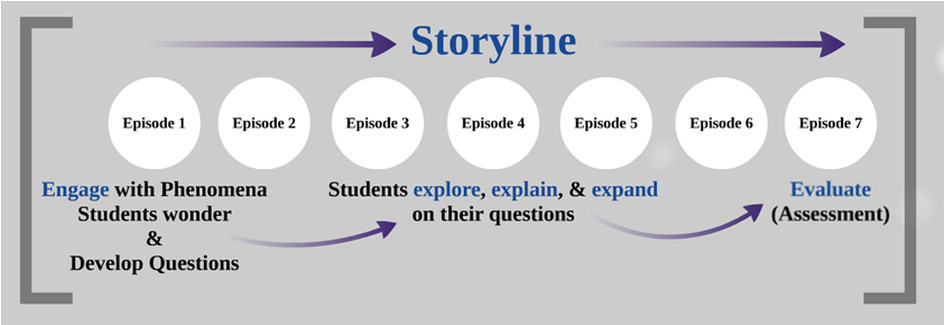
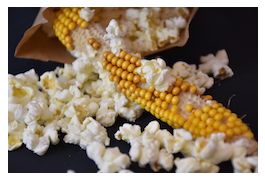
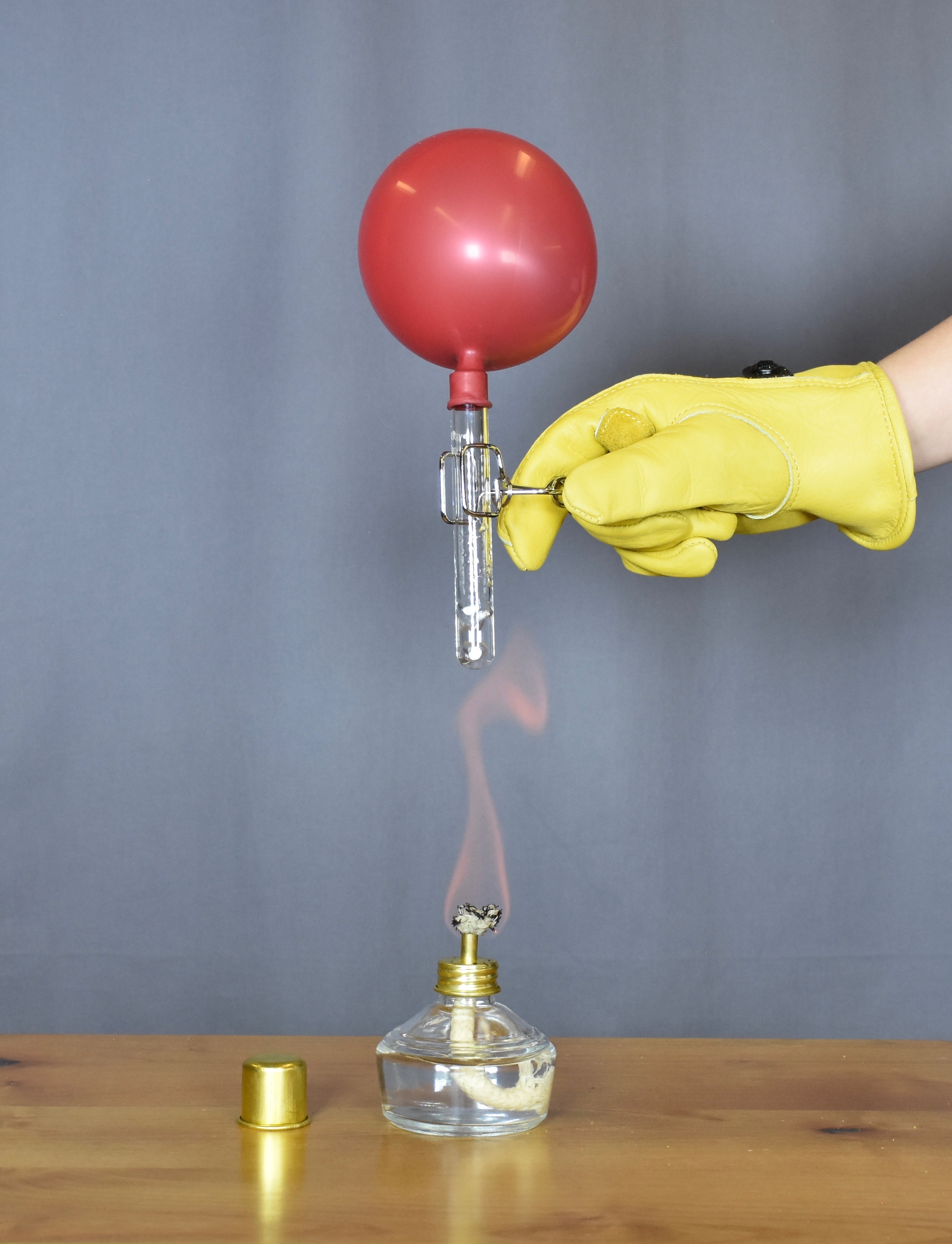 It will take about 45 seconds-1 minute for the water to begin to boil. At this point, hold the test tube straight up to allow the steam to enter the balloon. As the water reaches the boiling point, ask the students, "What are you observing?" (The water is changing to steam. The steam is expanding and trying to escape, inflating the balloon with its pressure.) Ask the students to predict what they think will happen to the balloon and why. (Eventually, the steam will create enough pressure to explode the balloon.) It will take about 1-1.5 minutes for the balloon to inflate and about 1.5-4 minutes or more for the balloon to pop.
It will take about 45 seconds-1 minute for the water to begin to boil. At this point, hold the test tube straight up to allow the steam to enter the balloon. As the water reaches the boiling point, ask the students, "What are you observing?" (The water is changing to steam. The steam is expanding and trying to escape, inflating the balloon with its pressure.) Ask the students to predict what they think will happen to the balloon and why. (Eventually, the steam will create enough pressure to explode the balloon.) It will take about 1-1.5 minutes for the balloon to inflate and about 1.5-4 minutes or more for the balloon to pop.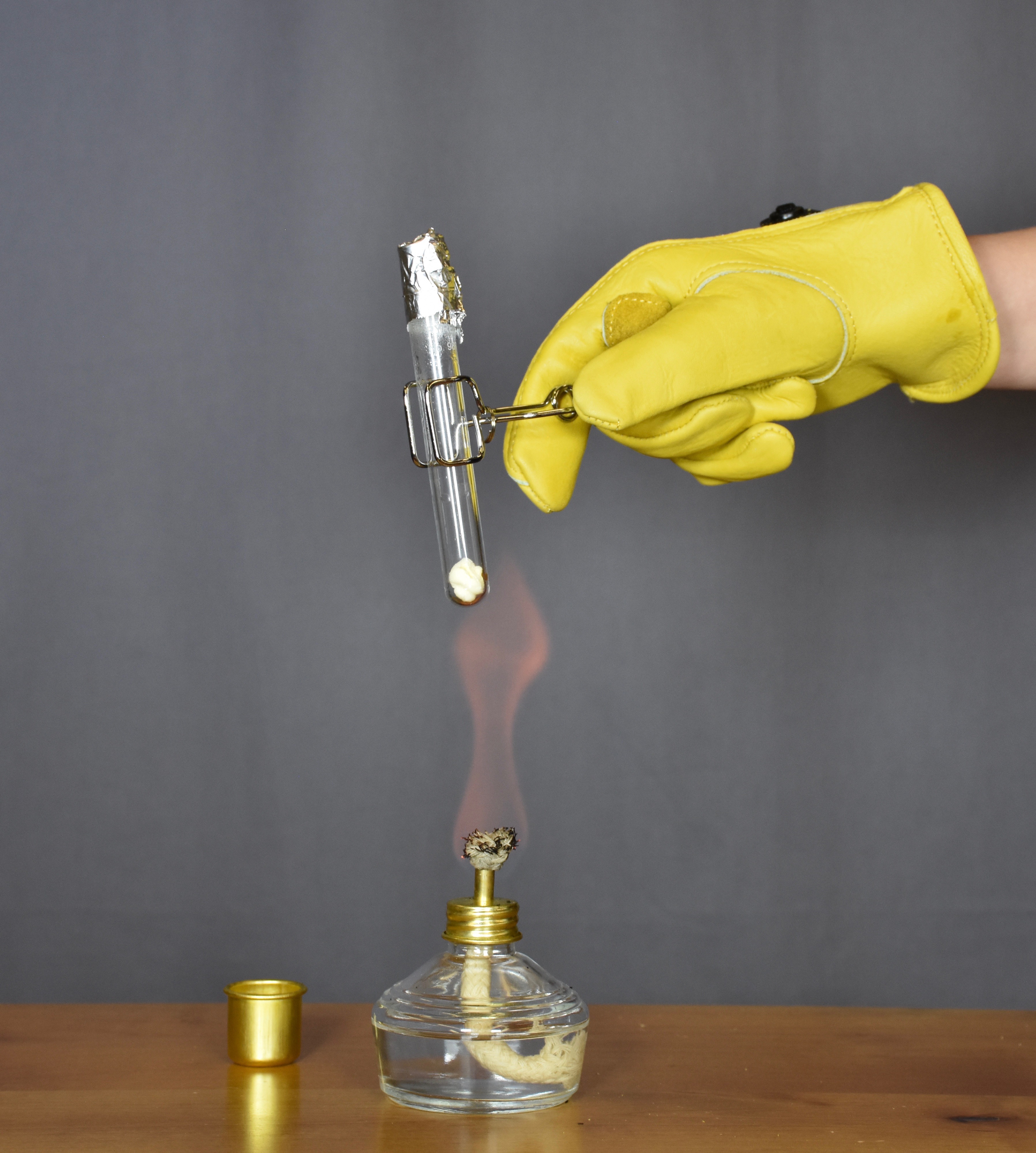 remind the students that popcorn kernels contain water. Ask them to predict and explain what will happen if a kernel of popcorn is heated in a test tube.
remind the students that popcorn kernels contain water. Ask them to predict and explain what will happen if a kernel of popcorn is heated in a test tube.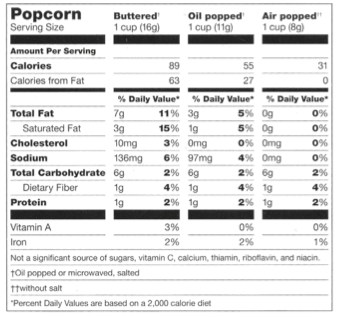 Put three cups of air-popped popcorn into a bowl, show it to students, and write the calorie content (93 calories) on the board.
Put three cups of air-popped popcorn into a bowl, show it to students, and write the calorie content (93 calories) on the board.